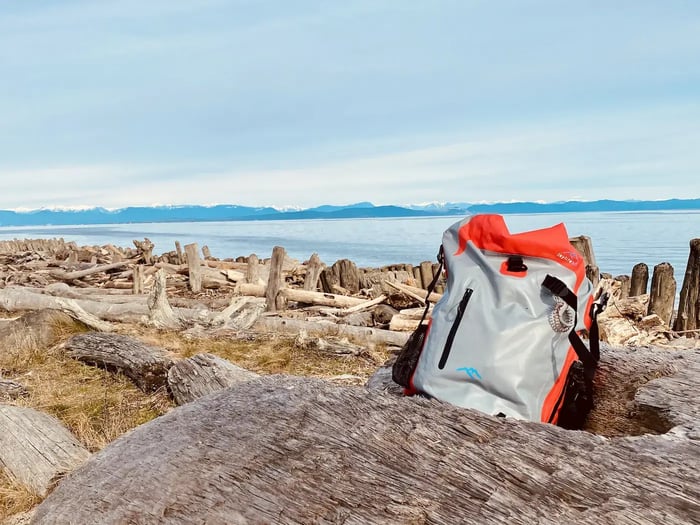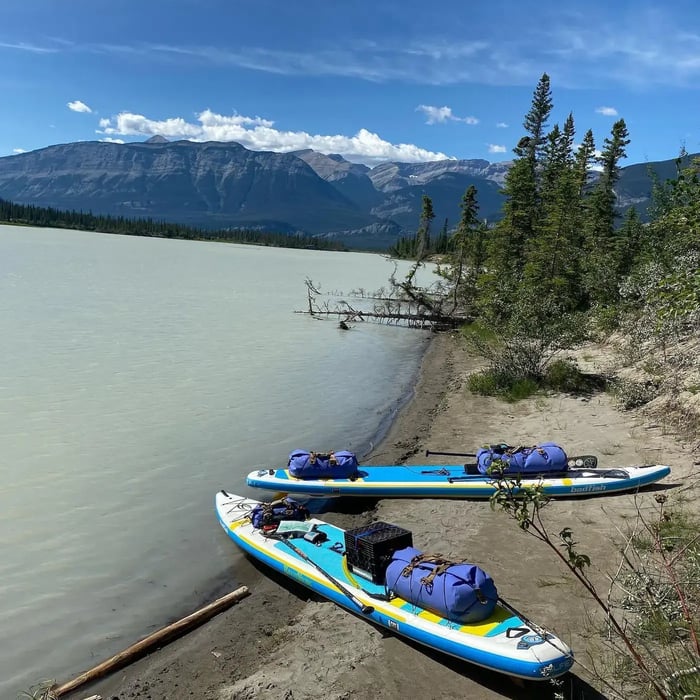Wahoo!! Your inflatable SUP has arrived, you're off to the lake or maybe to your first SUP Class. You’ve unrolled your SUP and now you’re thinking: how do I inflate my paddleboard?
Or maybe you’ve been out a few times and are thinking: am I inflating my SUP enough? Am I inflating it too much? Is it OK to keep my SUP inflated? How do I store my SUP?
Well, in this article, I’ll answer all these questions using my experience as both a paddleboarder and a SUP instructor.
How to Inflate Your SUP
- Unrolling and Setting Up Your Inflatable SUP
- How to Inflate Your SUP Paddleboard
- How to Deflate Your SUP Paddleboard
- 1. Take your fins off first to protect them from damage
- 2. Unscrew the valve cover
- 3. AVOID leaning over the valve
- 4. Depress the valve stem down and twist to hold it in the open position
- 5. Roll your board up loosely from the non-valve end
- 6. Release the valve stem to the up position before screwing the valve cover back on
- How to Roll and Store Your SUP Paddleboard
- Underinflating Your SUP Paddleboard is a Big Problem
- Automatic SUP Paddleboard Pumps
- PUMPED!
- Related SUP Articles
Unrolling and Setting Up Your Inflatable SUP

You unroll your SUP, the smell of fresh plastic fills your nostrils. The excitement is palpable. At the beginning it seems pretty straightforward: stick the hose from the pump into the valve on the board. Check.
But as you pump, it seems to be taking forever and you get tired. Should it be this tough?! Just when you think you’re done, and you release the hose from the valve, air comes rushing out. You just stick the valve cover on.
This seems so easy, but isn’t. There were a few key points missed in properly inflating your SUP! Follow along.
How to Inflate Your SUP Paddleboard

1.What is the PSI number listed around the valve?
Look at your valve casing, it often says maximum inflation values. 15-18 PSI is common, depending on the brand.
Remember – if it’s cold out be on the higher side, hot out maybe the lower end as the heat will expand the air in it.
The gauge on your pump (if your pump has one) should hold at the PSI shown on the gauge if you have inflated it high enough. If not, the reading will fall to zero, meaning that there isn’t sufficient air.
2.Ensure your SUP valve stem is up
This is the small piece inside the casing. It is on a spring. If you push it and twist one way the valve stem stays down. Do this the opposite direction it will pop up. Before pumping, the valve should be up so air doesn’t spew out.
3. Hook your hose onto the pump first, then the SUP
If you do this in reverse and there’s any air in the SUP, it will come out. So always hook up the pump to the board after the hose is already attached to the pump.
4. Are you on 2 stage pumping?
Many SUP pumps come with a selector switch on the side which will take you from double action pumping to single action pumping.
That means on “2” it will inflate on the upstroke and downstroke, which is more efficient at first. But as your board nears inflation it gets really hard to pump. When this happens, switch to “1” so you only inflate on the down stroke. This makes it easier to complete the inflation.
5. Remove hose carefully and put the valve cover on
Sometimes the hose will depress the valve stem inside and you will still get air gushing out. Not very often, but it does happen, especially with some electric pumps.
Don’t panic, just top it up if it loses air. Always put the cover on, whether inflated or deflated, to prevent debris from accidentally getting in the valve, and / or ripping a loose valve cover from your SUP.
How to Deflate Your SUP Paddleboard
After a great paddle on the water, if you want to fold up your SUP to transport there’s a few key points to remember:
1. Take your fins off first to protect them from damage
IF your SUP has removable fins.
2. Unscrew the valve cover
3. AVOID leaning over the valve
There is enough PSI at first release to damage your ears or eyes.
4. Depress the valve stem down and twist to hold it in the open position
5. Roll your board up loosely from the non-valve end
6. Release the valve stem to the up position before screwing the valve cover back on
How to Roll and Store Your SUP Paddleboard

I avoid tightly rolling my paddleboard, as it creates wear points that can become weaknesses over time. Even storing it slightly inflated once you get home can be an easy solution; provided you have the space.
If your only answer is rolled up, then ease off on the tight fold. Unless I’m flying somewhere, I never have my boards back in the original bag.
It’s great having options for storage and travel with inflatables. Treat them well and they will last a long time.
Underinflating Your SUP Paddleboard is a Big Problem

The most significant problem with an underinflated SUP is glide and use. Paddling a taco that is folding onto itself across the water results in a poor SUP experience. The paddleboard will be less stable and you will have less control maneuvering it around the water.
I always double check my client’s boards, as the most common mistake with new paddlers is underinflated SUP’s.
Pumping up your SUP is hard work. People often think that when it becomes harder to push, it means the SUP is at the proper air pressure. This isn’t necessarily the case.
But how will you know when your SUP is the correct pressure if you don’t have a gauge? Buy a pump that has a gauge! Nowadays most paddle packages come with a pump. If not, the Level Six High Pressure pump is a great option.
The durability of your paddleboard depends on it being fully inflated, which makes it is less prone to punctures and damage.
Automatic SUP Paddleboard Pumps

Using an electric SUP pump is a game changer for many. However, notice if the pump you’re using is specific for large inflatables and high PSI inflation. If your pump gauge only goes to 4 PSI, chances are you’re not making it to 17.
Is the adapter on the end suitable for the SUP valve? It needs to have a compatible hose end to be able to pump up your board.
The beauty of automated pumps is many have a setting so it automatically shuts off when it reaches a specific PSI, leaving you time to get the rest of your gear ready.
Check out the Aquaglide Accelerator Pump, it’ll shorten the time it takes you to get out on the water.
A couple side notes:
1.Make sure the hose on the pump seals tightly. Sometimes the vibration or the pump causes it to loosen.
2. Check the angle of the pump and hose. Any abrupt angles can cause the hose to untwist.
PUMPED!
I hope that gives you a better understanding of how to pump up your SUP inflatable paddlboard, and how to take proper care of it. Now that you're pumped up, enjoy the ride!
Happy paddling.
I Live Life Now,
Lisa Stocking
AQ AMBASSADOR
CSEP-CPT/RYT 200 Yoga Instructor
Advanced Flatwater SUP Instructor Paddle Canada
Related SUP Articles
Beginner's Guide to Flatwater SUP
Whitewater SUP, Everything You Need to Know
AQ Outdoors Contact
Edmonton: (p) 780 463-4892 (e) info@aquabaticsedmonton.com
Calgary: (p) 403 288-9283 (e) info@aqoutdoors.com





















































